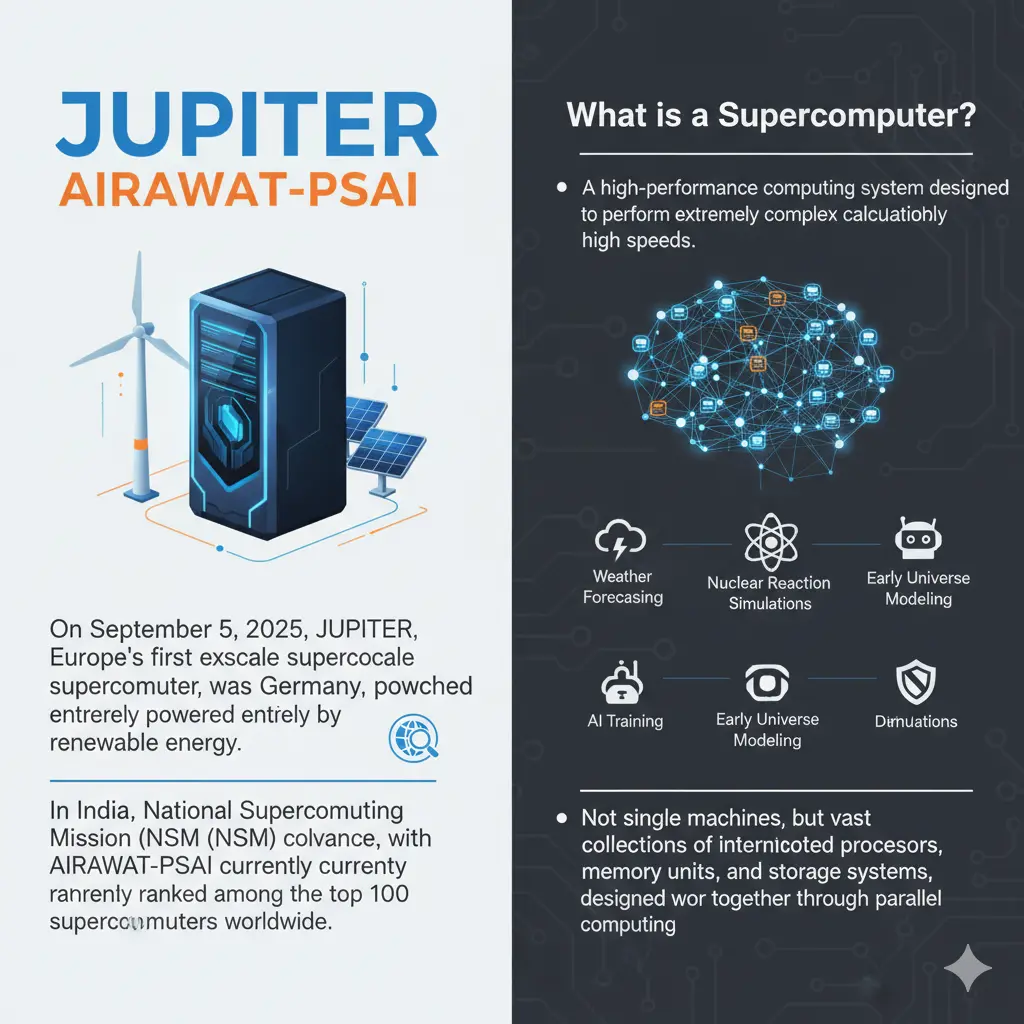September 22, 2025
JUPITER & AIRAWAT: 5 Powerful Facts on Supercomputers
On September 5, 2025, JUPITER, Europe’s first exascale supercomputer, was launched in Germany, powered entirely by renewable energy.
- In India, the National Supercomputing Mission (NSM) continues to advance, with AIRAWAT-PSAI currently ranked among the top 100 supercomputers worldwide.

What is a Supercomputer?
- A supercomputer is a high-performance computing system designed to perform extremely complex calculations at incredibly high speeds.
They are used for tasks like weather forecasting, nuclear reaction simulations, early universe modeling, AI training, and defense simulations. - Supercomputers are not single machines, but rather vast collections of interconnected processors, memory units, and storage systems, designed to work together through parallel computing.
How a Supercomputer Works?
- At the heart of a supercomputer is the principle of parallel computing. Instead of relying on one processor to work extremely fast, thousands or even millions of processors work simultaneously, each solving a small part of a problem. These partial solutions are then combined to produce results much faster than a single processor could.
Core Components:
Processors:
- The CPU (Central Processing Unit) handles general tasks.
- The GPU (Graphics Processing Unit), initially created for gaming, is excellent for repetitive mathematical operations like those needed in scientific simulations.
- Many modern supercomputers use both CPUs and GPUs for maximum efficiency.
Nodes:
- A node is a group of processors combined with memory, functioning like a small computer.
- A single supercomputer may have thousands of nodes, connected by a high-speed network that allows rapid data exchange.
Memory and Storage:
- Each node has dedicated memory for quick access to data.
- For storing massive datasets, supercomputers use specialized storage systems that can hold petabytes (millions of gigabytes) of data.
Cooling Systems:
- The intense activity generates enormous heat.
- Cooling is achieved through water pipes, refrigeration units, or special liquid immersion systems to prevent hardware damage.
Power Consumption:
- Running a supercomputer requires as much electricity as a small town, necessitating efficient power distribution and sometimes green energy sources.
Software Used in Supercomputers
The software manages how thousands of processors communicate, share data, and execute tasks efficiently.
- Operating System: Schedules tasks, manages memory, and controls data flow.
- Parallel Programming Languages:
- MPI (Message Passing Interface)
- OpenMP (Open Multi-Processing)
These languages instruct each processor on what to do and when to exchange information.
- Load Balancing:
Ensures processors don’t sit idle while others are overloaded, optimizing both speed and energy efficiency.
Performance Measurement:
- Measured in FLOPS (Floating-Point Operations per Second).
- Laptops: Billions of FLOPS.
- Top Supercomputers Today: Operate in exaflop range (quintillions of operations per second).
- One exaflop machine can perform more calculations in one second than all humans on Earth could in their lifetimes.
How Users Interact with a Supercomputer
- Supercomputers are remotely accessed via secure connections.
- Users prepare job scripts, specifying:
- What program to run
- Required computing resources
- Time duration for the task
- The scheduler software organizes these jobs, distributing them across available nodes.
- After completion, the output data (images, numbers, simulations) is stored and downloaded for analysis.
About National Supercomputing Mission (NSM):
The National Supercomputing Mission (NSM) is a flagship initiative of the Government of India aimed at developing world-class supercomputing infrastructure, indigenous hardware and software technologies, and building high-performance computing (HPC) capacity for scientific research, weather forecasting, AI, defense, and industrial applications.
Launch and Implementation:
- Launched: March 2015
- Duration: 7 years (later extended due to delays)
- Budget: Rs 4,500 crore (approx.)
- Implementing Agencies:
- Centre for Development of Advanced Computing (C-DAC) – for design and development
- Indian Institute of Science (IISc), Bengaluru – for research and academic collaboration
- Ministries Involved:
- Department of Science and Technology (DST)
- Ministry of Electronics and Information Technology (MeitY)
Objectives of NSM:
- Build 70+ high-performance computing facilities across India, with varying capacities ranging from teraflops to petaflops.
- Reduce dependency on foreign supercomputing systems by developing indigenous hardware, software, and processors.
- Support scientific research and innovation in diverse fields like climate modeling, weather forecasting, drug discovery, defense simulation, AI, and machine learning.
- Create a national network of supercomputing resources accessible to academic institutions, R&D labs, and industries.
Build human resource capacity by training professionals and researchers in high-performance computing.
September 24, 2025
September 23, 2025
September 22, 2025
September 17, 2025
